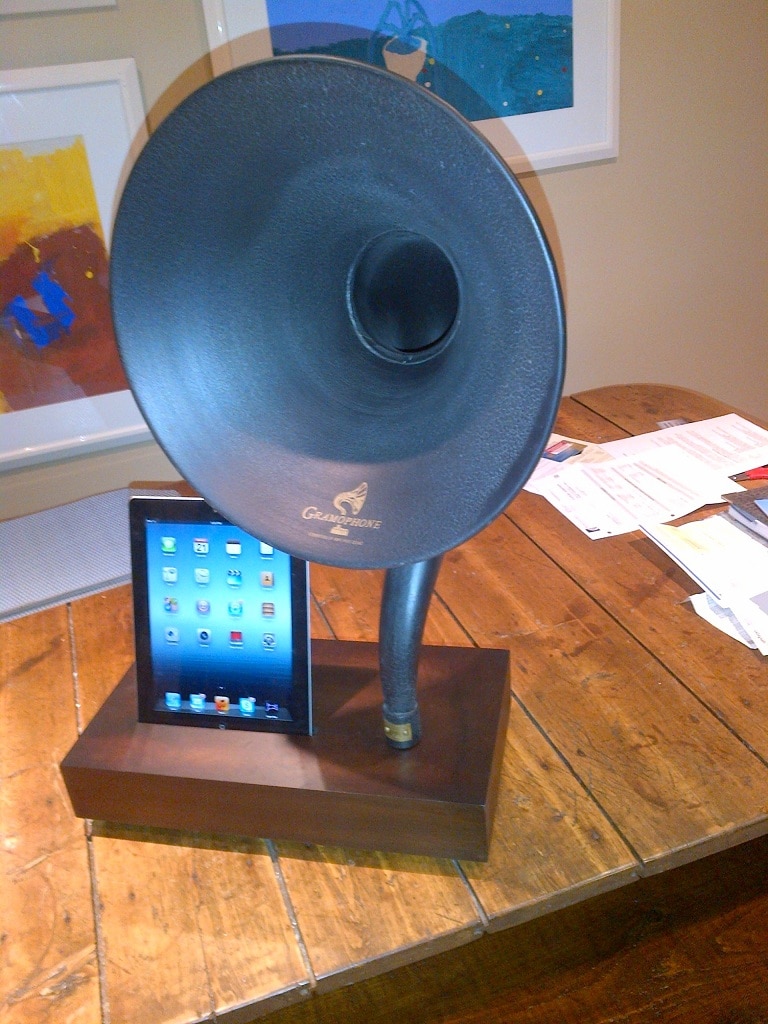Several weeks ago a friend of mine came over. He is about 15 years younger than I and is a drummer for a rather famous rock band. My son had just come home, having recently graduated from the Berklee School of Music in Boston. And for Christmas, I had just received an ironically low-tech acoustic amplifier for my iPad.
Here we have three generations of people all discussing music recording and playback issues from a digital perspective (my son), an analog one (my friend), and, as always, I took the acoustical perspective. What could only have been imagined 50 years ago in the realm of recording and playback became a partial analog reality 40 years ago, and today, anything can be done. Current digital recording devices use post-16 bit architecture, and run on 120 volts and a couple of amps. Current digital hearing aids, at the best of times, function as 14-15 bit systems, and need to be stable down to 1 volt.
Nevertheless there are some neat parallels between the history of hearing aids and the history of recording and playback systems- both have gone through an acoustical period; followed by an analog one; and now a digital one.
But maybe because I am an old guy (age 58), and maybe because I grew up audiologically at a time when acoustic modifications were still necessary given the limitations of analog hearing aid processing, I feel that there are still some things that we (and musicians) can learn from basic acoustics.
This is a picture of my nerdy, but neat, Christmas present. If I were in my teaching mode, I would describe this as an acoustic transformer with length L, which possesses an amplification factor equal to the log of the ratio of the cross-sectional areas of the narrow part of the tube divided by that of the larger part of the flare, and that the enhancement of sound would begin at the frequency F=v/2L where v is the speed of sound and L is the length of the tube. I would also say that there is a Helmholtz resonator (the box that the horn is sitting on) with volume V, and with a well-defined neck length and cross sectional area.
The wooden box would resonate at about 150 Hz and there would be a gradual high frequency enhancement above about 150 Hz- the net effect yielding an amplification of about 10-12 dB with a slight high frequency bias.
If I was not in my teaching mode, I would just say that it was funky and neat. It is also ironic that we have a digital iPad playing music being made louder through some old style acoustical plumbing.
We can even use what the early sound recording engineers knew in modern day hearing aids. Thomas Edison would have used an acoustic flare in his Victrola to enhance the loudness, but the tube length L was about 1000 mm (1 meter). Edison knew that F= v/2L was the frequency where the higher frequency amplification would begin. Using L=1000 mm and v=340,000 mm/sec (speed of sound) then F=170 Hz. That is, all sounds above 170 Hz are enhanced by the flare in his Victrola. This would tend to sound a bit tinny, which is why my modern day Christmas present uses a wooden stand with an internal volume that resonates at about 150 Hz- this low frequency shelf provides a warmth to the sound that would otherwise not be there.
Well, of course Cy Libby was the modern day Thomas Edison and in the 1980s, he came out with a single piece of flared hearing aid tubing that flared from 2 mm to about 4 mm. This doubling of the internal diameter resulted in 6 dB of free amplification above F=v/2L.
So let’s do some math… including the part of the acoustical tubing that is within the hearing aid that joins the receiver to the shell of the aid, plus the ear hook for behind the ear style hearing aids, and the length of the tubing that joins the hearing aid to the ear mold, we have a total length of 75 mm. The start frequency of the high frequency enhancement would be F=340,000mm/sec/2 x 75 mm = 2266 Hz. So, the gain of all frequencies above 2266 Hz is enhanced by the Libby horn. What about the amplification factor… how much free gain do we get? This is 10log(π(4)/ π(1)) = 10log4 = 20log2 = 6 dB.
So an acoustic horn that is 75 mm long enhances the amplification of all sounds over 2266 Hz by up to 6 dB. The dimensions of my Edison-inspired Christmas gift has an amplification factor of 12 dB! My fiancée and I spent a lovely evening in front of a romantic fireplace with a glass of wine calculating this.
Well other than romance, what are some other benefits of acoustical amplification for today’s thin-tube hearing aids? Doing the math again, we see that a thin tube with an internal diameter of 1 mm, if we flared it slightly to 2 mm (placing a small piece of #13 tubing over the end of the thin tube that protrudes into the ear canal), we also calculate a 6 dB high frequency advantage!
That is, any doubling of the internal diameter will provide 6 dB of free amplification- it doesn’t matter whether it flares from 2 mm to 4 mm or from 1 mm to 2 mm.
I say “free amplification” because for this 6 dB of high frequency amplification, this does not affect battery life (it occurs after the hearing aid circuitry) and maintains the headroom between the OSPL90 curve and the gain curve. Even in modern day fittings of behind the ear style hearing aids (non-occluding or not), there are some clear advantages in making acoustical modifications rather than some electrical ones.
Acoustic modifications and calculations can have some great benefits, and these include romance in front of fireplaces, free high frequency amplification, better battery life, and maintenance of head room.
I may be 58, but let’s not forget the advantages of acoustics in today’s modern music recordings and hearing aid fittings. And don’t even get me started on the advantages of analog circuitry over digital when it comes to amplified music!






